Review: LIFX Mini takes on Philips with Apple HomeKit
The LIFX Mini is about what you'd hope for from an iPhone-compatible smartbulb, and with HomeKit, LIFX is finally ready to go toe-to-toe with the popular Philips Hue platform.
We tested two versions of the Mini: the standard model, which supports 16 million colors, and the Mini White, which is limited to a warm 2,700K color temperature. A third variant, Day & Dusk, simply straddles the gap by offering various warm and cool tones of white, much like the Hue White Ambiance. You can achieve the same effects with the full-color bulb.
The primary advantage of a Mini is cost. Whereas the flagship LIFX bulb costs $59.99, its Mini equivalent is $44.99. A Mini White is $24.99 -- a lot more budget-friendly for people wanting to equip an entire house or apartment. Multi-packs are available too.
All three Minis offer adjustable dimming, and a peak brightness of 800 lumens. That's about the same as most smartbulbs, but much less powerful than the 1,100 lumens on a full-size LIFX. Indeed during testing the color model we found some shades were noticeably weaker, so plan your lighting accordingly.
One of the chief advantages of LIFX is that each bulb has its own Wi-Fi radio, eliminating the need for a hub (except for HomeKit -- see below). This makes setup relatively easy, though you'll need a LIFX account to "claim" each light, and you'll probably have to run firmware updates to make HomeKit setup and controls work properly.
Another issue we encountered was that the Mini operates only on 2.4-gigahertz Wi-Fi, not 5 gigahertz. Depending on your Wi-Fi setup that might make it difficult for an iPhone or iPad to see a bulb, particularly if you have several neighbors running their own 2.4-gigahertz networks.
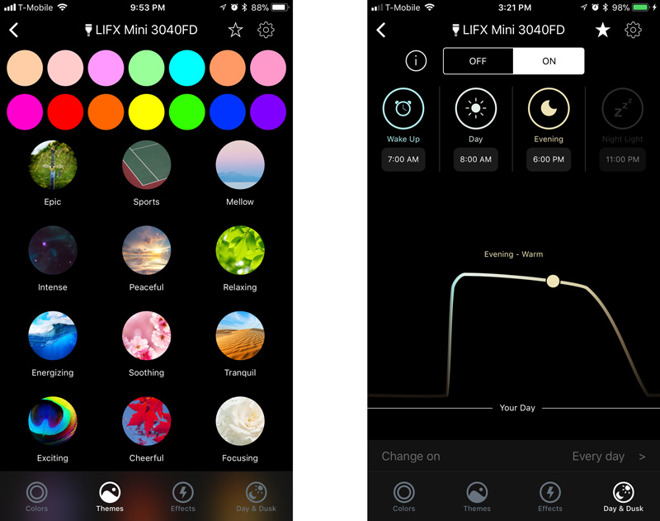
Particularly important is the "Day & Dusk" mode, which adapts brightness and color temperature to the time of day. You can't tweak those settings directly -- instead you set up "Wake Up," "Day," "Evening," and "Night Light" phases, toggling them on and off and choosing start times. The results were pretty pleasing though, to the point that we eventually preferred it to HomeKit for a morning routine.
We'll also briefly tip our hat to the fact that LIFX offers native iPad and Apple Watch interfaces. Some accessory makers work on the assumption that you'll always have an iPhone handy -- which, even if you do own one, isn't always practical.
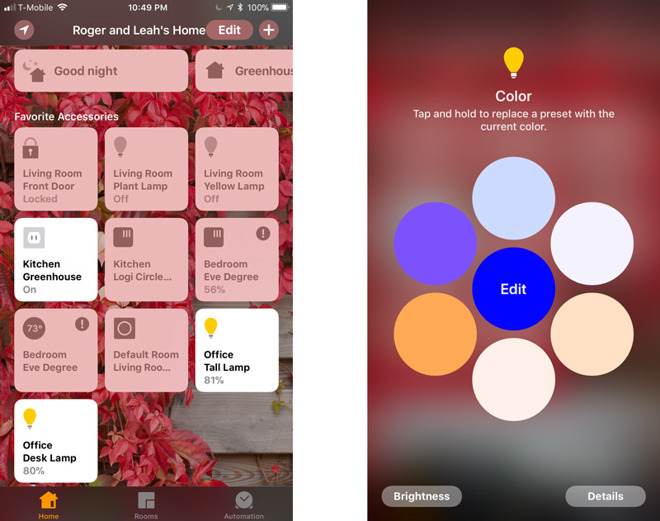
There's not too much to say in connection to LIFX specifically, but there are some important limits. You'll need an Apple TV, iPad, or HomePod running as a hub if you want remote access and automation, and the iOS/watchOS Home app will only let you command a bulb to change to a specific brightness and/or color, or else turn off completely.
There are also integrations with Nest and Scout Alarm, the former being the more interesting since a Nest Thermostat, for instance, can trigger random lighting while you're on vacation, or a Nest Cam can be set to dim lights when when motion quiets down. Both systems can trigger visual alarms.
Should you pick a Mini over a Hue, or some other smartbulb? Well, that depends. If you already have a Hue hub and matching lights, you might as well stick to that platform unless you're encountering specific problems.
If you're fresh to the smarthome world or not particularly loyal, we'd say you should strongly consider LIFX -- price out options, check your Wi-Fi network. It's nice not having a hub hogging an Ethernet port, and with HomeKit, Philips' early advantage has been kicked away.
The more critical question is whether you should pick a Mini or a full-size LIFX. The latter is better if want a single bulb to cover an entire room, or simply if you want the brightest lights possible. Otherwise, the Mini should do the trick.
We tested two versions of the Mini: the standard model, which supports 16 million colors, and the Mini White, which is limited to a warm 2,700K color temperature. A third variant, Day & Dusk, simply straddles the gap by offering various warm and cool tones of white, much like the Hue White Ambiance. You can achieve the same effects with the full-color bulb.
The primary advantage of a Mini is cost. Whereas the flagship LIFX bulb costs $59.99, its Mini equivalent is $44.99. A Mini White is $24.99 -- a lot more budget-friendly for people wanting to equip an entire house or apartment. Multi-packs are available too.
All three Minis offer adjustable dimming, and a peak brightness of 800 lumens. That's about the same as most smartbulbs, but much less powerful than the 1,100 lumens on a full-size LIFX. Indeed during testing the color model we found some shades were noticeably weaker, so plan your lighting accordingly.
One of the chief advantages of LIFX is that each bulb has its own Wi-Fi radio, eliminating the need for a hub (except for HomeKit -- see below). This makes setup relatively easy, though you'll need a LIFX account to "claim" each light, and you'll probably have to run firmware updates to make HomeKit setup and controls work properly.
Another issue we encountered was that the Mini operates only on 2.4-gigahertz Wi-Fi, not 5 gigahertz. Depending on your Wi-Fi setup that might make it difficult for an iPhone or iPad to see a bulb, particularly if you have several neighbors running their own 2.4-gigahertz networks.
Control: LIFX app
As with most smarthome accessories, you'll need a proprietary app to get the complete range of options and settings. This includes a range of preset room themes, like "Sports" and "Soothing," along with effects like color cycling, candle flicker, and a microphone-based music visualizer. Some of these are gimmicky, but many can't easily be replicated in HomeKit.
Particularly important is the "Day & Dusk" mode, which adapts brightness and color temperature to the time of day. You can't tweak those settings directly -- instead you set up "Wake Up," "Day," "Evening," and "Night Light" phases, toggling them on and off and choosing start times. The results were pretty pleasing though, to the point that we eventually preferred it to HomeKit for a morning routine.
We'll also briefly tip our hat to the fact that LIFX offers native iPad and Apple Watch interfaces. Some accessory makers work on the assumption that you'll always have an iPhone handy -- which, even if you do own one, isn't always practical.
Control: HomeKit
HomeKit, of course, means that that the Mini can be integrated into complex scenes and automations, as long as any third-party accessories have the same support. Your lights can turn off when you leave home for example, or on when someone unlocks the front door. If you don't care about Day & Dusk you can create time- and date-based triggers, including ones relative to sunrise and sunset.
There's not too much to say in connection to LIFX specifically, but there are some important limits. You'll need an Apple TV, iPad, or HomePod running as a hub if you want remote access and automation, and the iOS/watchOS Home app will only let you command a bulb to change to a specific brightness and/or color, or else turn off completely.
Control: Other hardware & software integrations
If you're not comfortable depending solely on Apple hardware, the Mini also works with things like IFTTT, buttons by Flic and Logitech, Logitech's Harmony Elite remote, and two other voice assistants in addition to Siri, Amazon Alexa and Google Assistant. We were able to test our bulbs with Amazon's Echo Dot speaker, which worked perfectly fine.There are also integrations with Nest and Scout Alarm, the former being the more interesting since a Nest Thermostat, for instance, can trigger random lighting while you're on vacation, or a Nest Cam can be set to dim lights when when motion quiets down. Both systems can trigger visual alarms.
Conclusions
If there's anything close to a serious gripe we have with the Mini, it's only that on the standard model, colors we picked in the LIFX or Home apps sometimes didn't translate into the real world. In those cases, it was just a matter of experimenting until the right shade appeared. The Mini White produced a very soothing light perfect for bedrooms or late-night work.Should you pick a Mini over a Hue, or some other smartbulb? Well, that depends. If you already have a Hue hub and matching lights, you might as well stick to that platform unless you're encountering specific problems.
If you're fresh to the smarthome world or not particularly loyal, we'd say you should strongly consider LIFX -- price out options, check your Wi-Fi network. It's nice not having a hub hogging an Ethernet port, and with HomeKit, Philips' early advantage has been kicked away.
The more critical question is whether you should pick a Mini or a full-size LIFX. The latter is better if want a single bulb to cover an entire room, or simply if you want the brightest lights possible. Otherwise, the Mini should do the trick.

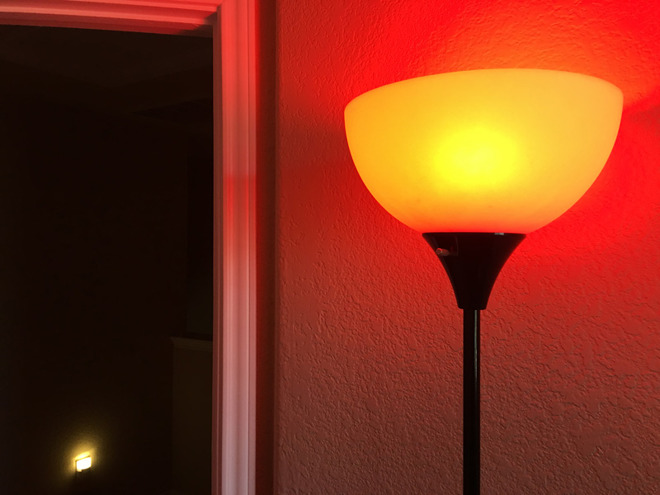
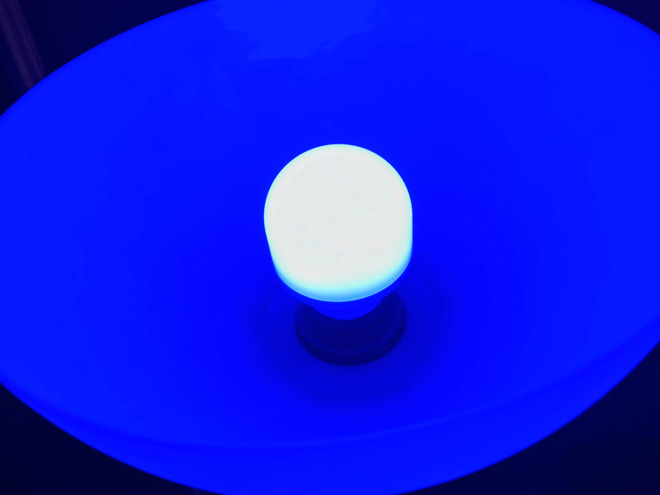
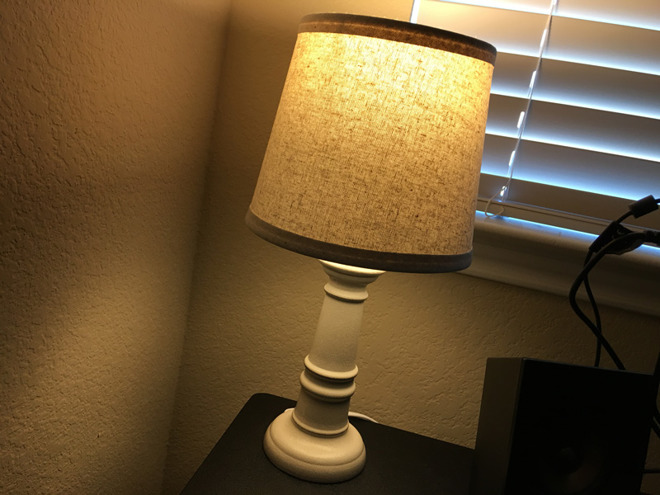
Comments
Reasons for Lifx:
App is better layout ( to me this is the most important reason to chose Lifx since you use it every day)
No hub, each bulb is WiFi so if your hub errors out not all your bulbs go down (one reason a friend switched)
1100 lumens compared to Hue 800
I would talk to friends who own both and play with their bulbs before purchasing. If you can’t do that view YouTube comparisons.
I use a few Z-wave controlled items (with Vera Lite as the hub) but haven't made the jump to Homekit yet. Keep these articles coming!
Edit: I should say that I prefer Z-wave over WiFi due to WiFi being used for ever more devices (Z-wave uses a different frequency). So I'm waiting for a Z-wave controller that plays nicely with Homekit. Vera has said they would make one, but no details were given.
Please don't get confused and think that any company that started on Kickstarter is a player.
Philips uses Zigbee Light Link which is a Mesh protocol. They don't use Hubs. Hubs route IP and that's not whats going on here
A Bridge is designed to join two network whether they be similar in network protocol or dissimilar. Hue lights and Lutron lights will
continue to work even if the bridge fails because they use their own protocols (Zigbee and Clear Connect) for bulb to bulb communication.
I know this because i've had my Hue system for near 5 years and even internet outages have little effect.
Next Lifx is a proprietary wifi communication. Ever notice how you don't have Lifx motion sensors
wall switches etc? Philips Hue Motion sensor and Wall Switch support HomeKit
The article also makes the mistake of opining about why 5Ghz isn't supported. This is a range issue
speed isn't the issue here with control signals. Zwave, Zigbee and Clear Connect all can operate around the
800-900mhz frequencies which allows them to reach mesh points that are further way. With Wifi you don't want to
go to a shorter (5Ghz) reach when you may have lights on the outside of far edges of a home that may disconnect
because of low signal.
Lumens
"This one goes to 10".
Light you home as you wish but the general rule of thumb for commercial and residential lighting is
"you light features ...not spaces". When you walk into a well lit home your eyes will seek out the bright
spots and in these spots will be pieces of art or unique architecture. If you walk into a home with no highlighting
and the bulbs cranked up to max lumens you're going to see a very bland interior
My first post was just trolling. I like Lifx alot but Lutron and Philips have profitable commercial ventures that allow them to
produce Hue and Caseta as hobby projects. They are the class of lighting for residential at this point. Lifx is Snapple...a solid
third.
Been using Hue for three years never had an error on the hub and for the app: all you need to do is push a button.
Creee LED bulbs with Candlelight dimming
both have more of that orange yellow incandescent color as they dim.
https://www.usa.philips.com/c-m-li/warm-glow-dimmable-led-lighting
http://creebulb.com/40-watt-candelabra-replacement-soft-white-candlelight
I bought 2 Lifx bulbs to try. Yes, they brighter with good colours but the app is terrible, setup is poor, physical controls require expensive aftermarket switches and hubs and, despite Lifx saying it could be done, I can’t get them to function with the Hue switches.
I don’t want to carry a phone around with me in the house or have to ask Siri to turn lights on and off.
I'm a big fan of Hue.
evilution said: My thoughts exactly. I'm using a Flirc usb IR receiver with a Raspberry Pi to program Hue into my universal remote (I used to use Flirc and my Mac for this too, but a few months ago, I bought a $35 Pi for my entertainment center. It's a slick setup).
For instance, somehow I got a pre-HomeKit sensor to accept a 'scene' of turning on a light in red during some night hours. During the day it's white. I tried to do the same with a second sensor and second light and it doesn't work. If the second light is already on at night (red) activating the sensor will turn the light on but white.
I am nowhere near using IFFFT or using code to change the behavior of the sensors or lights like some supernerdgeeks do.
And while using my Watch to control my lights is generally handy, Siri is the worst digital assistant. It routinely 'miss-hears' me. My rain-in-Spain elocution is excellent, but Siri doesn't care. So HomeKit, at the moment, is batting .650. That said, it's still been more convenient than getting up and doing it myself. If I could just iron out a few kinks...
My main full time complaints about the Hue system are:
1) that the bulbs are maxed at 800L and that's only at around 4000ºK. Output drops on either side of that.
2) Hue only does bulbs and sensors, not switches for appliances. I understand that to sell switches could cost them some sales in bulbs, but I'll have to get an additional system for devices.
This is where Philips future support for all Zigbee 3.0 certified products may bear significant fruit. It will allow other vendors to
create products that Philips isn't interested in creating and so long as they behave properly in Zigbee 3.0 they will be recognized
on the Hue Bridge.
I'm envisioning Green Power (no electricity) wall switches, in-wall Zigbee AC outlets, motion sensors and more as options.
Also expect to see more Wifi Routers integrating Zigbee radio. The Google router does and the Linksys Velop. I bet more are
coming.